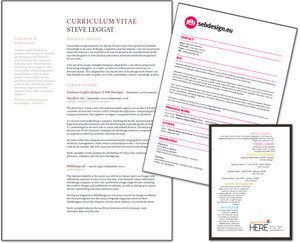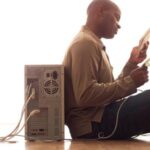Recently, I wrote an article that gave techies tips on crafting the “technically perfect” resume. As I was writing it, though, I kept thinking to myself how different aspects of the tech industry have such different requirements. As a graphic designer, ad designer, or any “crafty” designer you can get away with things that a technical resume cannot. The graphic designer’s resume can be so much more eye-catching. In fact, it can be totally out of this world and be all the more stellar for it.
Graphic Designer Resume DO NOT’s
A few things that apply to any technical resume definitely hold true for writing a graphic designer or an illustrator. The most important “rules” that you still have to follow are:
1. DO NOT use super-tiny fonts. It doesn’t matter if they’re pixel fonts that are perfectly legible at 9 points. It’s simply not good practice. No potential employer wants to have to squint just to see what you’ve written. They won’t do it – your beautifully crafted piece of resume art will hit the trash.
2. DO NOT write your resume or its cover letter in the third person. It’s perfectly acceptable to use “I” and “my” where you need to. Let’s not get all freaky with the third person artist thing.
3. DO NOT include your photograph. First of all, an employer should be interested in your skills and areas of expertise. That’s what your graphic design resume is for, obviously. We don’t live in a perfect world, and not only do photographs turn some employers off immediately, but they can also be used against you and you’ll never really be able to “prove” that you were discriminated against. But let’s be realistic and admit that it does happen far more than it should.
4. DO NOT list off your personal interests, activities, hobbies, date of birth, or anything else that doesn’t directly impact your ability to perform the job you’re applying to. Seriously, the potential employer could care less.
5. DO NOT “stuff” your resume. Resume stuffing occurs when you start listing off every piece of software you’ve ever touched as a skill. Be completely honest. For example, I can honestly say that I’ve got way too many years (I’m not admitting how many!) of coding HTML, java, and PHP “from scratch.” Just because I also used some obscure piece of Adobe software back when I was 18 to read slides in as pictures for the newspaper, though, doesn’t mean I’m skilled at it. If I listed it as a skill and were unfortunate enough to be hired because of it, I’d be left looking like a fool when I couldn’t properly use the software. Only list what you truly are skilled at, and be honest about how skilled you really are.
Graphic Designer Resume Blueprint
As a graphic designer or illustrator, you’re more than familiar with templates, blueprints, outlines, and other materials that help you objectively create exactly what the customer wants. In this case, your customer is a potential employer, so the heat’s on. Before you start sweating it, take a few seconds to familiarize yourself with what pieces, or sections, a professional graphic designer resume contains. Then, you can write your resume without half as much head-banging-against-desktop.
Knowing the sections that should be on your graphic design resume is vital. These resumes don’t follow normal procedure, and a “typical” resume template won’t work in most cases. Remember, you’re an artist. As such, your resume will be at least as important as your portfolio – some would argue that it’s even more important, because it gets you to the point of showing off that portfolio in the first place.
In order, here is your graphic design resume blueprint:
Name and Contact Information – Seriously, the best I’ve seen for this “section” looks very much like a business card. Your name, the words “graphic designer,” and all your contact information need to be prominently displayed and easy to read.
Statement – Also known as an objective, mission statement, or personal statement, this is the spot where you briefly state your goals and let your resume reader know just how much your skill will benefit their company. What I can’t say strongly enough about this section is this: tailor the statement to the specific employer and position you’re applying for. Don’t make the statement a generic objective. Instead, use the exact title of the position, do some research on the company and use words that fit in with their own mission statement (which you can usually find on the company’s website under the “About” link) so that your resume stands out if for no other reason than you are a perfect jigsaw-like fit.
Experience – Your job experience is important, but for a graphic designer’s resume it can also be tricky. If you’ve been working a lot of project-based jobs that weren’t for a single company, list this experience as “Freelance Work.” Otherwise, start with your job title. Either way, include the employment dates and a brief description of the work you did, major projects you accomplished, and — where possible and only if it doesn’t make the section too long — include links where those major projects can be viewed.
Education – Most graphic designers attended and graduated with a degree from a single school. In this case, you would want to list your degree and major, month and year of graduation, college name and location (city and state), and the degree you now hold. Don’t be ambiguous. If you didn’t graduate, don’t leave the employer hanging. Instead, state how many credits you have left before graduation, or give a very brief explanation as to why you didn’t graduate and how you’ve gotten past that lack of education with hands-on experience.
Skills and Abilities – Here is where you can really shine, with or without a degree in graphic design. The skills and abilities section of your resume allows you to write about things like your extensive experience working one-on-one with clients, managing multiple projects simultaneously, and how you are able to meet or beat deadlines with high-quality results. In a way, this is the “sales pitch” portion of your graphic design resume.
Software Skills – In most cases, using columns or tables in your resume is a big no-no. However, that “rule” can be thrown out the window if you have true skills in different technical areas. Bulleted, in columns, or headed by category, you get to show off your software, coding, drawing hardware, and other design-related skills in this section.
Awards – No, not all of us have them. If you don’t have any awards, think about contests you’ve won or magazines, prominent industry blogs, or shows that you and/or your work has been featured in. List them simply in a Title | Brief Description | Year format. Modesty is, after all, a virtue.
Organizations – Another section that not every graphic designer can include in their resume, but one that employers love to see; being involved in the design community shows how dedicated you are to your work and how much enthusiasm you’re likely to bring to the job. If you’re involved in a design-related organization or two, list them here with a link to the organization’s official site.
References – Seriously, you do not have to list references directly on your graphic design resume. Many experts actually recommend that you don’t. Instead, do mention that “References are available upon request” and type up a list of official references that you can give if they’re requested. Official, though! Don’t fill your references section with friends, family, previous co-workers, and the guy who is so nice when he delivers your mail. Ask for permission from references before you include them, and make sure they have authority – professors, previous bosses, former clients or customers, team managers, etc.
Getting Crafty with Your Graphic Designer Resume
Short and sweet: you can make your graphic design or illustrator resume really pop with actual art. Yes, seriously. From eye-catching colors to a sine wave layout of text, header graphics to highlight the name and contact info portion of your resume …
I’ve seen all of these, and never fail to be surprised and impressed when I come across a new way to show off as a graphic designer in something as “formal” as a resume. Think of ways that you can alter the traditional, or take a look at the illustration attached to this article for inspiration; you’ve got your own creativity. Use it.


